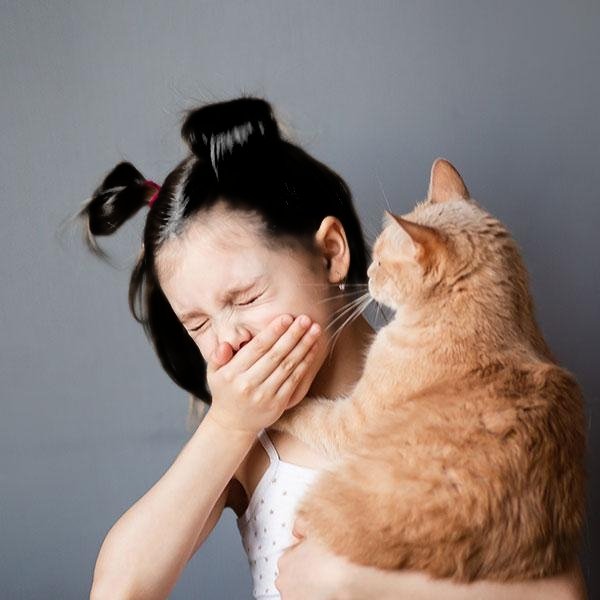Welts, tears and stuffy nose
Cat Allergies - A cat lover’s foe
50% of WinterForest Siberians join families with either one member or all members that suffer from cat allergy.
Being allergic to cats ourselves, we can relate to the woes of wanting a loving companion that may trigger the ever irritating tearing and dripping nose.
For those that suffer as we do, Siberian cats seem to be a promising alternative. Which begs the question, are Siberian cats truly free of dander causing allergies ?
The truth is , there are no allergy free animals.
The Siberian cat is not a magic bullet for all cat allergy sufferers, but the Siberian cat has been scientifically tested and proven, as a breed to have lower FEL D1 levels when compared to all other breeds.
Research has shown that approximately 50% of mature , intact Siberians have lower than average FEL D1 levels with 15% of them safe for homes with severe reactions to cats.
Once Neutered, the percentage of Lower than Average FEL D1 jumps making majority of Neutered Siberians suitable for moderate to mild allergy suffers.
Mild reactions are localized and may present as a rash or hives . Itchiness, watery / red eyes and runny nose.
Moderate reactions are similar but spread or have a mild general effect for example, whole body itch versus just your nose. It may also include swelling and trouble breathing.
Severe reactions are life-threatening. It usually has a strong and sudden onset and may involve anaphylaxis, fainting, severe itching and people that suffer from them carry a Epi-Pen around and will need medical attention when triggered.
Cats produce FEL D1 to 8 .
FEL D1
The main culprit that causes all the fuss. Found in Cats and produced largely by Saliva and Sebaceous glands located in their skin.
Ranked by Breed
(Lowest)
Siberian
Kurilian Bobtail
Javanese
Balinese
Russian Blue
Bengal
(Highest)
Persian/Himalayan/ Exotic
Maine Coon
Norwegian Forest
Manx
FEL D2, D3, D4
Found in cats. Usually in the waste , blood or fur but generally trigger mild or no symptoms
Do not be mislead into thinking that a short fur or furless cat will be more hypoallergenic. Short fur cats generally shed more due to their shorter growth phases.
FEL D1 found mainly in saliva is not affected by the amount or length of fur a cat possess and triggers 90% of cat allergy sufferers.
Despite everything, sometimes a Siberian owner develops a strong reaction to their cat, in such instances, there are now certain diets for cats that bind the proteins in the saliva and thus reduce allergy symptoms in their humans.
Most cat allergy suffers are allergic to more than one substance for example , other animals , pollen, dust or even food. These allergies may impact your ability to live comfortably with your cat. Highlight this to your breeder and depending on the severity and variety of your allergies, your breeder would be better able to assist you.
Where possible, work with a breeder near you. Should that not be possible, ask friends with Siberian cats or owners living near you that maybe willing to allow you to interact with their cats and get a cat of similar parentage. With luck this would help to increase your chances of getting a suitable cat and help narrow your search.
Armed with the above knowledge, doesn’t mean that any Siberian cat will do. Adjustments to lifestyle and home will need to be made to accommodate a Siberian. The first 3 months will be the most difficult as stress levels trigger higher FEL D1 levels in cats.
If you suffer Moderate to Severe allergies , it would be better to consider Older Neutered Siberians.
FEL D1 levels are lowest in older neutered cats and Highest in unneutered male and or dark colored( traditional) cats.
Not every Siberian or cattery producing Siberians will produce Hypo-allergenic Siberians.
Studies show that a diverse bloodline crucial, more important than the pairing of low allergen adults. A diverse bloodline has a higher probability of producing low allergen kittens. ( Check out our other article on selectively breeding out Color-point Siberians)
Surprisingly, Traditional Siberians are not more Hypoallergenic than Color-pointed Siberians ( Neva Masquerades) - as FEL D1 is lower in lighter colored cats.
Sometimes pregnant woman are pressured into giving up their cat, take some comfort in knowing that research suggests that pregnant woman exposed to cats generally reduces the allergy reaction in their infants and young children and these children generally do not develop severe reactions compared to those that were not.
Sometimes pregnancy also causes allergies , but that will be explored in another article ..
With close to 15% of all adults being allergic to cats. IE. When throwing a party of 10 friends, its likely 1 of them will end up feeling a little flu like after being around a normal cat and young children aged 7 to 18 being more likely to be allergic to cats compared to adults. Perhaps starting of with a lower allergen cat might be a good thing.
As mentioned not all catteries consider allergies as a factor in their breeding plans, there are others that go as far as to test all their breeding cats and young kittens with that as a main focus. Testing cost upwards of $800 per time and the results fluctuate. Affected by age and stress the results are sometimes less conclusive in young kittens.
If you or a family member suffers from cat allergies, it’s always best to speak to your breeder about it. Let them know your concerns. Each cattery approaches this differently and has established their own methods towards testing. It is a time consuming and pain staking process that you will need to decide on before embarking on this journey together.


